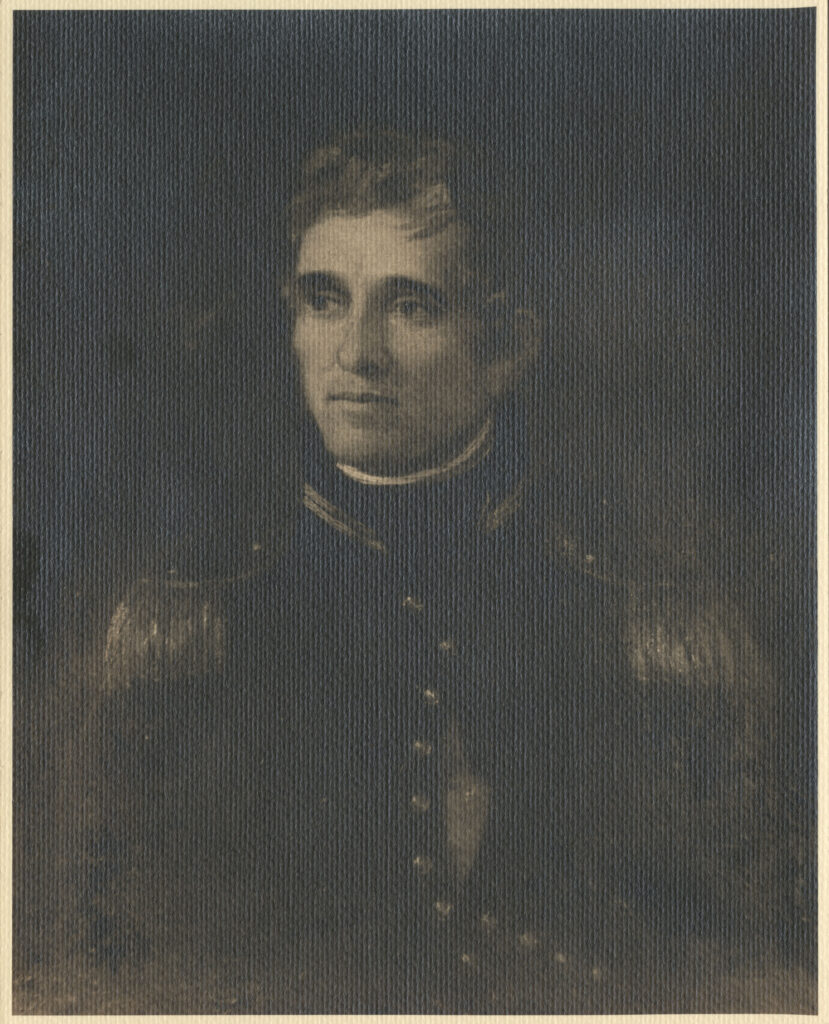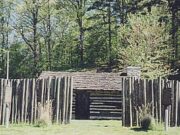The War of 1812 was fought between the United States and Britain between 1812 and 1815.
The causes of the war were many: the impressing of American sailors into the British navy, British trade restrictions to Europe during the Napoleonic Wars, British military posts remaining on American soil long after the end of the Revolutionary War (1775-83), and what was perceived by Americans as a British plot to perpetuate continual Native American menace on America’s frontiers. It was inevitable that Georgia, with its long coastline and extensive Indian frontier, would become embroiled in the conflict, and yet Georgia’s role in the war has been largely overshadowed. Three main theaters of operation deserve recognition. These are the Creek War of 1813-14, the British blockade, and the British occupation of St. Marys and Cumberland Island in 1814-15.
The Creek War of 1813-1814
Early in the war British officials began arming many allied Native American tribes along the frontier. On August 30, 1813, a strong force of Creeks attacked and destroyed Fort Mims, an American post on the Alabama River, north of Mobile. Georgia figured prominently in the campaign to eliminate the threat posed by the warring Creek tribes. General John Floyd was given command of troops operating from Georgia.

Floyd, who later became a U.S. congressman, was ordered to establish several forts and to destroy all the Creek villages and their crops in his line of march. These actions were intended to culminate in the establishment of a continuous supply line of fortified posts from which the American forces could operate freely against the Creeks without fear of loss of war materiel. In September 1813 Floyd mustered a 2,000-man to 3,000-man army and gathered supplies for his campaign at Fort Hawkins, in present-day Macon. He deemed his force ready to undertake the operation by November. Floyd established Fort Mitchell, just across the Chattahoochee River, and marched steadily toward the Creek-held territory deeper in present-day Alabama. Floyd’s army, bolstered by a friendly Indian contingent, fell upon the Native Americans at the Creek town of Autosse on November 29, 1813. In a desperately fought action, Floyd’s men forced the Creeks to retreat after a bayonet charge. This allowed Floyd to destroy Autosse and a second town nearby. Lacking proper supplies, Floyd returned to Fort Mitchell. A long-range effect of the defeat at Autosse was that many of the Creek survivors made their way to the Horseshoe Bend area, where General Andrew Jackson would decisively defeat the Creek Nation the following year.
Floyd suffered from chronic supply problems but decided to take the field once again in January 1814. Floyd’s Georgians and their Native American allies began construction of Fort Hull, some forty miles west of Fort Mitchell. Floyd continued advancing farther into Creek territory. Thirteen hundred Creek warriors mounted a surprise attack against the encamped army on the banks of Calabee Creek on January 27, 1814. The assault was blunted by the Georgians’ use of artillery and superior fire. Nevertheless, the attack succeeded in dispiriting the Georgians, and Floyd retired to Fort Hull. Soon afterward, Floyd was forced by his army’s enlistment expirations to return to Fort Mitchell, leaving a small garrison at Fort Hull.
The new commander at Fort Hull, Colonel Homer Milton, was reinforced and spent the next several months continuing to harry the Creeks. He established the fortified posts of Fort Bainbridge and Fort Decatur in the disputed areas. Floyd’s and Milton’s activities ensured supplies that aided in Jackson’s successful battle at Horseshoe Bend, which in turn culminated in the defeat of the hostile Creeks on March 27, 1814.
The British Blockade
One of the concerns of Americans who voted for war against Britain in 1812 was the British navy’s heavy-handed enforcement of trade restrictions to continental Europe. This was, in part, due to Britain’s long-running war with Napoleonic France. Britain had established a strict blockade of French ports in continental Europe and as a result was short of ships and men. Consequently, the British seized American ships suspected of trading with French ports and conducted the impressment of American sailors. When war broke out, Georgia, with its long coastline and prosperous coastal cities, once again was on the front line.
Georgia had been subdued, for the most part, by the British in the American Revolution. Its coastal cities had been occupied, and in 1812 it seemed possible that a powerful British force could do so again. Little protection was forthcoming from the federal government because of its serious deficiency in ships and sailors. British warships hovered off Georgia’s coast, snapping up coastal trading craft and disrupting the livelihood of Georgians. Georgia’s citizens and leaders clamored for help. That help arrived in the form of a naval expedition to Sunbury, Georgia, in the summer and fall of 1812.
The navy decided to use Sunbury’s deep harbor as a staging area for several shallow-draft barges, or gunboats. These small craft were to ply the intercoastal waterway between Savannah and St. Marys and disrupt British attempts to capture and destroy American coastal trading ships. Unfortunately for the government and the people of Sunbury, the expedition came to a disappointing end because of poor planning, negligent leadership, and a serious lack of supplies. The failure of the Sunbury expedition left the Georgia coast open for British attack. To forestall this, the state set about building batteries at key locations, including the old Fort Morris at Sunbury (rebuilt and renamed Fort Defiance), the battery at Point Peter in St. Marys, and many other strong points on the coast. During the next year and a half no serious British threat emerged to endanger the Georgia coast, due in part to British efforts against Napoleon. In 1814, however, all that changed. Napoleon’s defeat in Europe freed thousands of hardened British regulars to move across the Atlantic and threaten the United States.
The British Occupation of St. Marys and Cumberland Island, 1814-1815
On December 24, 1814, American and British representatives meeting at Ghent, Belgium, signed a preliminary treaty that would end the War of 1812, but the combatants, far from Europe, knew nothing of it. Along Georgia’s coast American forces fared poorly. On January 10, 1815, British forces under the command of Admiral Sir George Cockburn landed on Cumberland Island in an effort to tie up American forces and keep them from joining other American forces to help defend New Orleans, Louisiana, and the Gulf Coast. But bad weather and lack of materials and ships delayed Cockburn until it was too late to produce any effect on the outcome of the battle for New Orleans. The occupation of Cumberland Island, however, left the British with a strong base of operations that they consolidated on January 13 by effecting a landing near the American battery at Point Peter on the mainland. There they encountered an ambush by a small force of Americans. The British quickly drove off the attacks and occupied the town of St. Marys.
Cockburn, by the end of January 1815, had solidified his base of operations and was under orders to await the arrival of Major Edward Nicolls, leading a joint force of British soldiers, Native American allies, and freed Blacks. Suitably reinforced, Cockburn was then to attack along the southern coast, liberating enslaved inhabitants and fomenting rebellion, thus holding down large numbers of American troops from other theaters of the war. Nicolls’s force, which was supposed to strike into Georgia from the Gulf Coast, never materialized, although it did succeed in disrupting communications between Georgia and Mobile. The threat of Nicolls’s impending arrival also forced the Americans to hold back in Georgia many reserves that could have been sent to aid in American defenses at Mobile and New Orleans. While Nicolls’s force hampered efforts on the Gulf Coast, Cockburn planned to move north and strike at Savannah. General John Floyd stationed some 2,000 men near Savannah and awaited the British thrust, but Cockburn’s operation was halted by news that the Treaty of Ghent had been signed. The British finally evacuated St. Marys after the ratification of the treaty on February 17, 1815.
The War of 1812 had lasting effects on Georgia. The freeing of enslaved Americans by the British occupation became a legal issue for years after the treaty ratification. Towns like Sunbury suffered a tremendous decline because of the damage inflicted on Georgia’s coastal trading fleet by the British blockade, and the question of what to do with lands ceded by the Creeks and other tribes would lead to major debates over state land policy.






